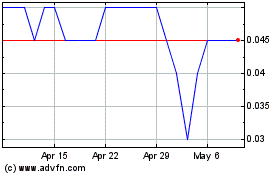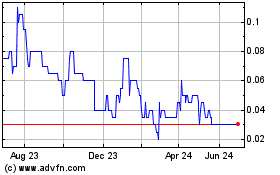Hemlo Explorers Inc. (the “Company”) (TSXV: HMLO) is pleased to
provide an update on the results of its diamond drill program on
Project Idaho, located two (2) kilometres southeast of Generation
Mining’s Marathon Palladium-Copper Deposit (“Marathon Deposit”).
The drill program consisted of 6 diamond drill
holes along a 3-kilometre strike length on the western side of
Project Idaho. The program was designed to drill test geophysical
VTEM anomalies situated along an inferred north-south trending
Coldwell Complex-Archean boundary, as interpreted by geophysics.
Ni-Cu-PGE bearing grab and soil samples, taken in the 2022 field
season coincided with the VTEM anomalies. A portion of the
north-south trend exhibited a strong magnetic reversal signature,
that is a magnetic attribute of the Marathon Cu-PGE deposit. A
total of 1,121 metres were drilled with an average vertical depth
of 151.6 metres (Table 1) in “Idaho West”.
A seventh hole, which was not part of the
geological model for Project Idaho, was drilled to twin a 1983
drill hole containing a high sulfide zone within Archean feldspar
porphyry. DDH PI-23-007 did not yield any significant
mineralization and was therefore not sampled.
Table 1. DDH information
|
Hole ID |
Northing* (mN) |
Easting* (mE) |
Dip (°) |
Azimuth (°) |
End of Hole Depth (m) |
Vertical Depth (m) |
|
PI-23-001 |
5,400,464 |
551,682 |
-45 |
050 |
253.3 |
179.1 |
|
PI-23-002 |
5,401,583 |
551,999 |
-85 |
032 |
101.0 |
100.6 |
|
PI-23-003 |
5,401,583 |
551,999 |
-85 |
215 |
83.2 |
82.9 |
|
PI-23-004 |
5,401,914 |
552,172 |
-60 |
330 |
266.2 |
230.5 |
|
PI-23-005 |
5,403,367 |
552,183 |
-49 |
320 |
256.8 |
193.8 |
|
PI-23-006 |
5,403,202 |
552,232 |
-50 |
210 |
160.5 |
123.0 |
|
PI-23-007 |
5,403,809 |
552,998 |
-75 |
090 |
269.1 |
259.9 |
|
Total |
1,390.1 |
|
*Coordinates are in UTM NAD83 Zone 16N.
Figure 1. Diamond Drill Hole Locations,
Total Magnetic Field, and Modeled VTEM Plates.
Key indicators of success for this initial drill
program on “Idaho West” was to discover lithologies, sulfide
mineralization, gabbroic textures, and pathfinder geochemistry that
are directly related to the mineralized portions of the Eastern
Gabbro within the Coldwell Complex. This is also known as the Two
Duck Lake Gabbro (“TDLG”). Such an advancement would support our
geological model of emplacement, in which sulfide-bearing mafic
magma emanated from the Coldwell Complex, flowing along conduits
and channels that correspond to deep-seated structures and major
lithological contacts. Highlights of the selectively sampled drill
results from DDH PI-23-001 through -006 are outlined below (Table
2).
It is important to note that the geological team
discovered TDLG-style lithologies, sulfide mineralization, gabbroic
textures, and pathfinder geochemistry as noted below:
- Coldwell
Complex-type mafic gabbroic lithologies were found in all assayed
drill holes;
- Sulfide
mineralization was found in all assayed drill holes, confirming the
validity of the modeled VTEM “plates”;
-
Importantly, two horizons of semi-massive to massive
sulfide mineralization were intersected near surface in holes
PI-23-002 and -003;
-
Anomalous coincident Ni, Cu, Pt, Pd and Au was found in
high mag zones (holes PI-23-001, -005, and -006); and
-
Rare-Earth Element (“REE”) geochemical “fingerprint”
similar to the mineralized portion of the TDLG of the Marathon
Deposit was discovered in 5 of the 6 drill holes [O’Neill, H.
(2016) J. Petrology 57 no 8, 1463-1508].
Table 2. Significant Intercepts and Geological
Significance
|
Hole ID |
Target |
Assays |
Geological Significance |
|
PI-23-001 |
-VTEM plate in CWC gabbros |
-263 ppm Cu over 13.7 m (200.25-213.95m), 192 ppm Ni over 22.6 m
(213.95-236.5 m)-One sample returned 17 ppb Pd and 16 ppb Pt within
Cu-enriched zone-Pathfinders: Cd, Co, Cr, Re, V |
-anomalous Cu and Ni values straddling contact between Coldwell
Complex (“CWC”) gabbros and Archean metavolcanics |
|
PI-23-002 |
-VTEM plate in low mag |
-121 ppm Cu, 105 ppm Ni over 2.0 m (3.81-5.86 m)-147 ppm Cu, 97 ppm
Ni over 1.6 m (11.8-13.4 m)-Pathfinders: Ag, As, Bi, Cd, Co, Mn,
Mo, Sb, Te, W |
-two horizons of semi-massive to massive sulfide with pyrrhotite
and pyrite mineralization-1 gabbroic sample with REE affinity to
TDLG |
|
PI-23-003 |
-VTEM plate in low mag |
-154 ppm Cu, 133 ppm Ni over 2.2 m (4.7-6.93 m)-235 ppm Ni over 2.2
m (75-77.2 m)-Pathfinders: Ag, Cd, Co, Mn, Mo, Re, Se, Te, W |
-22 gabbroic samples with REE affinity to TDLG |
|
PI-23-004 |
-VTEM plate in breccia zone |
-123 ppm Ni over 3.4 m (164.45-167.88 m)-168 ppm Ni over 3.0 m
(220-223 m)-Pathfinders: Cd, Co, Cr, Se, V, W, Zn |
-“rheological breccia” intercepted within interlayered gabbros and
volcanics-gabbroic unit containing fault/shear texture-9 gabbroic
samples with REE similarity with TDLG |
|
PI-23-005 |
-VTEM plate in central banded iron formation (“BIF”) |
-169 ppm Cu over 1.7 m with accompanying Pd (15 ppb) and Pt (17
ppb) anomalies (159.2-160.87 m)-Pathfinders: Ba, Be, Co, V, Zn |
-elevated Pd and Pt found within a mafic intrusive body in contact
with BIF-3 gabbroic samples with REE affinity to TDLG |
|
PI-23-006 |
-VTEM plate in northern BIF |
-173 ppm Cu over 3.6 m with 15 ppb Pd in one sample within the
intercept (22.9-26.51 m)-Pathfinders: Co, Re, Se, V |
-elevated Cu found at the contact between two gabbros having
different textures-5 gabbroic samples with REE affinity to
TDLG |
|
PI-23-007 |
Twinning historic DDH |
-no samples assayed |
-historic log from 1983 DDH recorded sulfide-bearing porphyry |
Exploration Planning for 2024
Drill results from the 2023 program are
encouraging due to confirmation of CWC-type mafic intrusives in all
assayed drill holes, many of which also exhibit REE geochemistry
similar to the mineralized TDLG at the Marathon Deposit. Also
encouraging is the discovery of semi-massive to massive sulfide
mineralization within the reversed magnetic portion of the N-S
trending magnetic anomaly, and the elevated coincident Ni-Cu-PGE
values that suggest a primary igneous source.
The team also observed TDLG-style textures such
as “pegmatitic gabbroic pods” within more fine-grained CWC-gabbros.
Planning is underway for the 2024 season to follow-up on these
results on the west side of the project (“Idaho West”). The
exploration team will trace out the path of the massive sulfide
horizons near surface from holes -002 and -003 with overburden
stripping and channel sampling to better define the sulfide
horizons to the west and at depth. Holes -001, -005, and -006
contain gabbroic intrusives with elevated coincident Ni, Cu, Pt,
Pd, and Au. Further targeting to the west and at depth is also
underway for these areas.
Sulfide mineralization causing the
high-conductance VTEM anomalies modeled from the 2022 airborne
geophysical survey have been identified as either massive and/or
coarse-grained in nature within holes PI-23-001 to -006. We will
revisit the Maxwell plate modeling to identify areas of lower
conductance, which may be caused by more disseminated sulfide
mineralization, similar to that of the Marathon Deposit. Historic
IP anomalies will also be incorporated in order to determine
whether any disseminated targets, similar to TDLG, lie within the
reversed magnetic and REE-geochemically-favourable zones. A 3D
magnetic inversion completed by Dr. Alan King of Geoscience North
will also be used to generate deeper drill targets for “Idaho
West”, especially in the northwest corner of the project area.
Project Idaho lies along the eastern flank of
the CWC and contains both radial and concentric faults related to
the eruptive event and volcanic caldera collapse. One such regional
fault runs E-W across the project area connecting “Idaho West” to
“Idaho East” (see red arrow on Figure 1). Also present along this
regional “conduit” are six historic diamond drill holes drilled by
Stillwater Canada Inc. within ground now held by Generation Mining.
These drill holes contain highly elevated platinum and palladium
values
(https://www.geologyontario.mndm.gov.on.ca/mndmfiles/afri/data/records/20000007337.html).
Along the same regional structure is a significant “jog” in the Pic
River, which coincides with a VTEM plate at the eastern bend in the
river.
A larger VTEM plate in Idaho East occurs along
strike from these Stillwater holes. Surface grabs collected by the
Company in 2023 above the VTEM plate contain anomalous Pt and Pd
values (see Press Release from October 2, 2023;
https://hemloexplorers.ca/news/2023/hemlo-explorers-announces-results-of-2023-mapping-and-sampling-program/).
This regional E-W structure is interpreted to be a magma “channel”
or “conduit”, potentially carrying Cu-Ni-PGE-bearing sulfide liquid
from the eruptive centre of the CWC from west to east. We are
excited and ready to explore for potential sulfide “traps” along
this new channel pathway in our 2024 program.
QA/QC
Drill core samples were tagged, cut, and bagged,
then sent to Activation Laboratories (“ActLabs”) in Thunder Bay,
Ontario. Samples were prepared by coarse crushing and pulverizing,
then sent for Au-Pt-Pd analysis by fire assay and ICP-OES, or
multi-element analysis by total acid digestion and ICP-MS/ICP-OES
finish. Analyses were completed in both Thunder Bay and Ancaster,
Ontario. Standards and blanks were inserted into the sample stream
every 20 and 40 samples, respectively, in order to test the lab’s
accuracy and precision.
Technical Information
Dr. Lesley Rose, P.Geo., Senior Exploration
Geologist for the Company, is the “Qualified Person” as defined by
National Instrument 43-101 Standards of Disclosure for Mineral
Projects, responsible for the accuracy of all technical information
contained in this news release.
About Hemlo Explorers Inc.
Hemlo Explorers is a Canadian-based mineral
exploration company with a portfolio of properties in Ontario and
Nunavut. We are focused on generating shareholder value through the
advancement of our main Hemlo area, including Project Idaho, the
Pic and North Limb Projects. Currently a portion of the Pic Project
is being explored by Barrick Gold Inc. under an option
agreement.
For more information please contact:
Brian Howlett, President & CEOHemlo
Explorers
Inc.brian@hemloexplorers.ca1-647-227-3035http://www.hemloexplorers.ca
Forward-Looking Information
Certain information set forth in this news
release may contain forward-looking information that involve
substantial known and unknown risks and uncertainties, including,
but not limited to, exploration results, potential mineralization,
statements relating to mineral resources, the advancement of
the Pic Project and the Company’s plans with respect to the
exploration and development of its properties. These
forward-looking statements are subject to numerous risks and
uncertainties, certain of which are beyond the control of the
Company, including, but not limited to, the impact of general
economic conditions, industry conditions, volatility of commodity
prices, risks associated with the uncertainty of exploration
results and estimates, currency fluctuations, dependency upon
regulatory approvals, due diligence risks, the uncertainty of
obtaining additional financing, exploration risk and Covid-19
pandemic related orders. Readers are cautioned that the assumptions
used in the preparation of such information, although considered
reasonable at the time of preparation, may prove to be imprecise
and, as such, undue reliance should not be placed on
forward-looking information. The Company does not undertake to
update such forward-looking information except as required by
applicable securities laws.
Neither the TSX Venture Exchange nor its
Regulation Services Provider (as that term is defined in the
policies of the TSX Venture Exchange) accepts responsibility for
the adequacy or accuracy of this release.
A photo accompanying this announcement is available at
https://www.globenewswire.com/NewsRoom/AttachmentNg/dd04bb06-a486-4d5b-a326-9871c079a4f3
Hemlo Explorers (TSXV:HMLO)
Historical Stock Chart
From Nov 2024 to Dec 2024

Hemlo Explorers (TSXV:HMLO)
Historical Stock Chart
From Dec 2023 to Dec 2024
